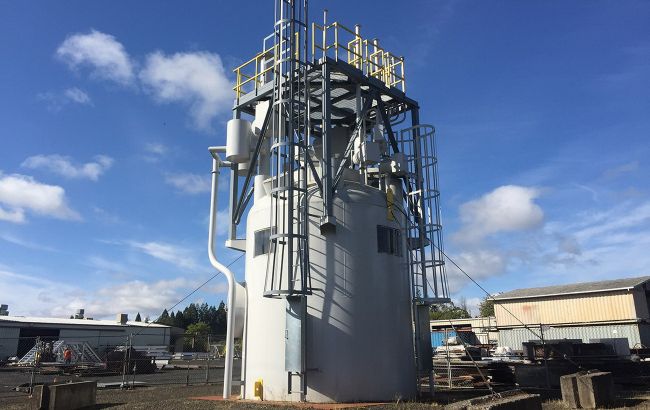New rules of the nuclear game: how Ukraine is preparing for the implementation of the SMR
31 October 15:49
Ukraine plans to allow the construction of private nuclear power plants that use only small modular reactors (SMRs) to produce electricity and/or heat as a commodity. Not only Ukrainians but also foreign citizens will be able to build private mini-nuclear power plants. What changes are proposed by MPs to the Law of Ukraine “On Amendments to Certain Legislative Acts of Ukraine on the Basis for the Implementation of Small Modular Reactors in Ukraine”, "Komersant Ukrainian" found out.
The current nuclear legislation of Ukraine was developed for large Soviet-type nuclear power units with a capacity of 1000 MW or more, so it does not take into account the peculiarities of small modular reactors (SMRs) – their modular structure, lower capacity (10-300 MW) and other requirements for safety, licensing and integration into the power grid, according to the explanatory note to the draft law. The absence of provisions on SMPs in the legislation does not allow:
- simplify construction licensing;
- place reactors at industrial sites or in the recovery areas of TPPs/ChPs;
- attract private investors to the small nuclear generation sector.
It is necessary to create legal conditions for private companies to participate in the construction and operation of SMRs under state supervision and in compliance with all nuclear and radiation safety requirements. This will attract investment, accelerate the restoration of energy infrastructure and reduce dependence on fossil fuel imports.
Paving the way for private mini-nuclear power plants
The draft law proposes to amend the Law of Ukraine “On the Use of Nuclear Energy and Radiation Safety” and related acts in order to
- update the definition of the operating organization (operator): for private SMRs, the operator is the owner, for state-owned SMRs, the operator is appointed by the Cabinet of Ministers of Ukraine; at the same time, mandatory licensing without a state monopoly is preserved
- to secure the right of the SMR owner not to be an operator (if the operation is outsourced to a professional company), which simplifies financing and risk sharing;
- simplify the site selection process by abolishing the requirement to submit three alternative options;
- allow the conversion of TPP/CHP sites into SMRs, subject to compliance with safety standards and environmental expertise;
- remove the state’s monopoly on SMR fuel, while retaining control over the management of spent nuclear fuel and radioactive waste.
The adoption of the law will allow:
- create a regulatory framework for SMR licensing and construction;
- develop public-private partnerships in the field of small nuclear power
- accelerate the restoration of energy infrastructure;
- reduce dependence on gas and coal imports;
- fulfill international commitments on decarbonization and integration into the EU market;
- create new jobs.
The implementation of the law will strengthen Ukraine’s energy sustainability and independence, increase electricity production by nuclear power plants, ensure the flexibility of the energy system in accordance with ENTSO-E standards, help maintain stable tariffs and increase export potential. It will also contribute to the growth of budget revenues and the fulfillment of Ukraine’s climate commitments.
SMRs will not appear in Ukraine soon
The idea of building SMRs in Ukraine is a great one, but it still has a long way to go, says Oleh Popenko, chairman of the Union of Consumers of Public Utilities. Small reactors are only being developed and have not been put into mass production.
“This is a very promising direction, of course. And it would help us a lot. But since 2023, only about 80 modular reactor projects have been developed. The first modular reactors, or rather their prototypes, appeared in Russia and China. But even if serial production of SMRs had already been launched, it would still take a long time from manufacturing to installation and launch,” emphasizes Oleh Popenko.
In addition, if we talk about safety, they can also be shelled during hostilities, and transformers can be damaged. Therefore, even if the question of installing such SMRs in Ukraine were raised today, investors might not dare. Instead, after the end of hostilities, SMRs can be a good help, because the country’s power system has been seriously damaged. No wonder the Verkhovna Rada wants to expand the energy market and allow private investors to produce and sell electricity.
“The expectation is to open the energy market, including for foreign capital. And this is right, because we will need investments,” emphasized Oleg Popenko.
Only two SMRs are already operating at full capacity
In fact, SMRs are a new generation of nuclear power units that can produce electricity, heat, hydrogen or desalinated water. They can replace coal-fired power plants and CHP plants without increasing CO₂ emissions, provide energy to remote regions and industrial zones, and attract private investment due to their modular design and lower entry threshold.
The average cost of SMRs ranges from $1.5 to $6 billion, depending on capacity and technology, making them an attractive alternative for rapid deployment of clean energy. Factory assembly reduces construction time to 3-5 years instead of 8-10 years for traditional nuclear power plants.
Today, the Akademik Lomonosov floating nuclear power plant with two KLT-40S reactors (~35 MW electric) is in operation (Russia, Chukotka Autonomous Okrug). The plant began commercial operation in May 2020.
Also, a high-temperature gas-cooled modular reactor (HTGR) was put into commercial operation in China, at the Shidao Bay site (Shandong Province) in December 2023. This is one of the first examples of this type of SMR in the world.
Author: Alla Dunina









